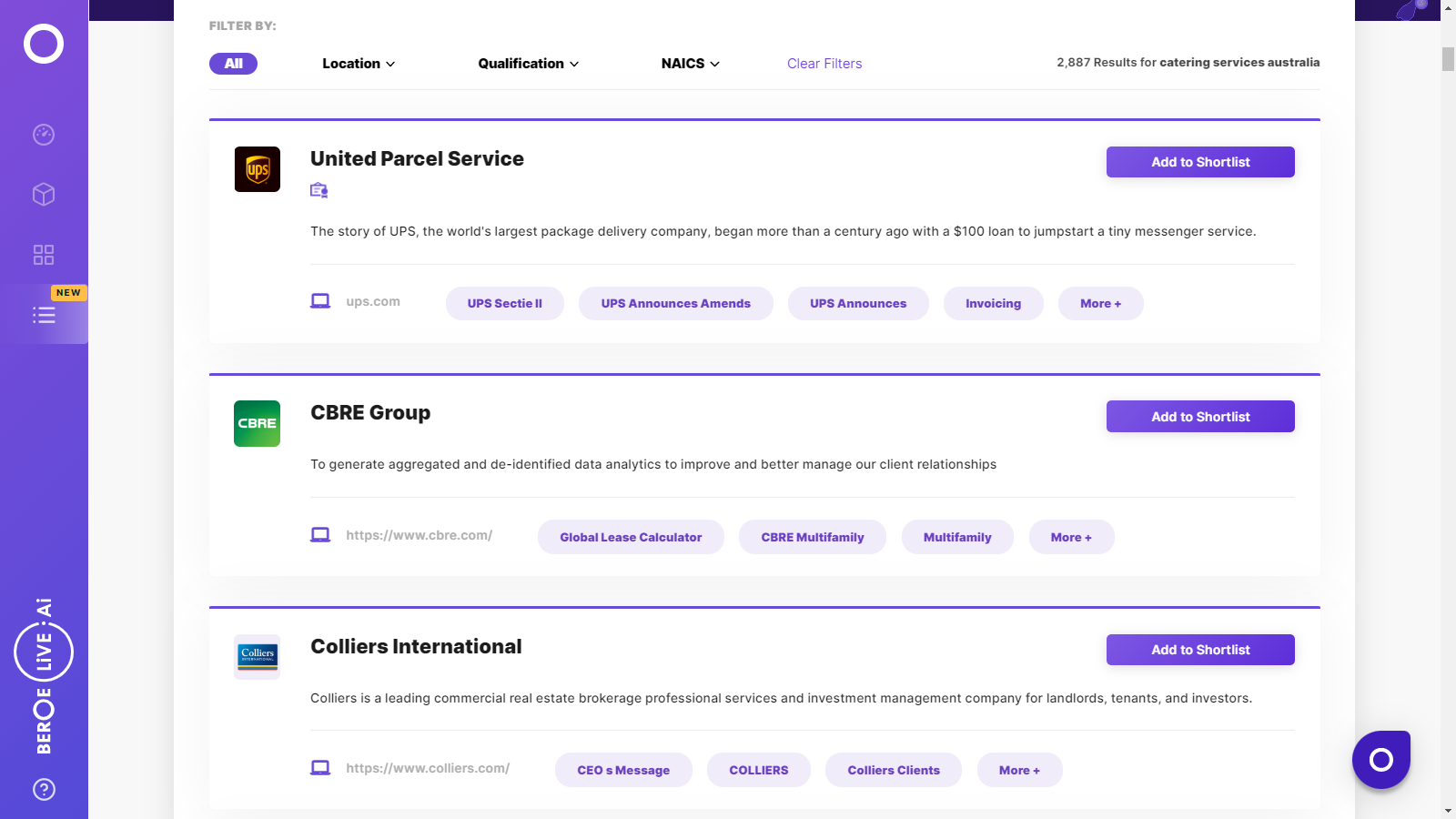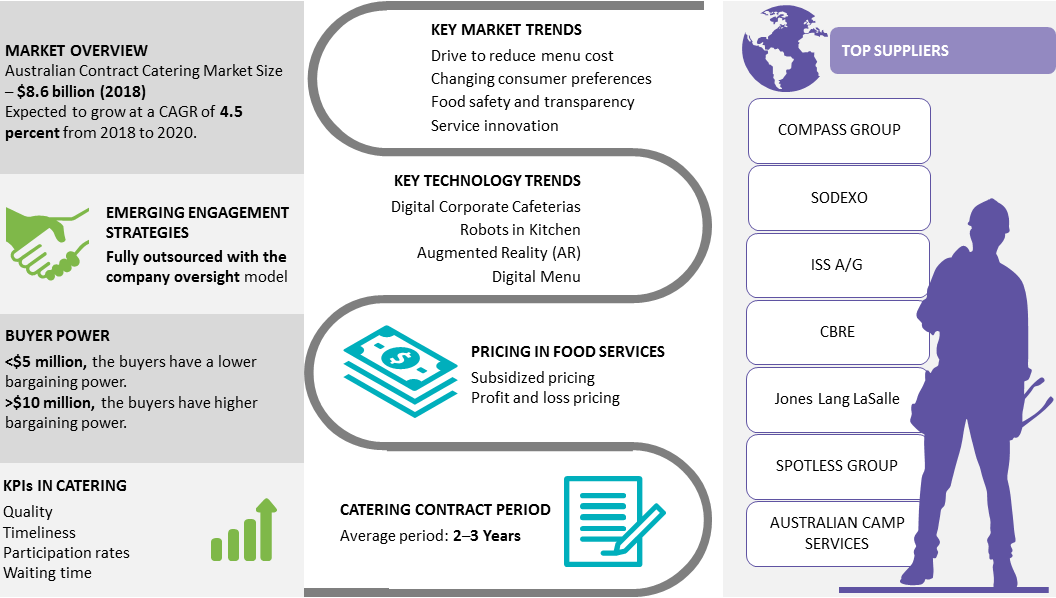CATEGORY
Catering Services Australia
Beroe LiVE.Ai™
AI-powered self-service platform for all your sourcing decision needs across 1,200+ categories like Catering Services Australia.
Market Data, Sourcing & Supplier Intelligence, and Price & Cost Benchmarking.
Schedule a DemoThe World’s first Digital Market Analyst
Abi, the AI-powered digital assistant brings together data, insights, and intelligence for faster answers to sourcing questions
Abi is now supercharged with GPT4 AI engine. Enjoy the ease of ChatGPT, now on Abi
Catering Services Australia Suppliers

Find the right-fit catering services australia supplier for your specific business needs and filter by location, industry, category, revenue, certifications, and more on Beroe LiVE.Ai™.
Schedule a Demo


Use the Catering Services Australia market, supplier and price information for category strategy creation and Quaterly Business Reviews (QRBs)
Schedule a DemoCatering Services Australia market report transcript
Regional Market Outlook on Catering Services
- The outsourced catering service market in Australia was approximately $8.6 billion in 2018, and it is expected to grow at a CAGR of 4.5 percent to $10.26 billion by 2022
- The market is highly fragmented, with a significantly high level of buyer maturity and supplier capabilities for outsourced catering services
- Direct operational presence of all major global catering vendors in the top tier cities as well as some large regional and local players in the market
- Catering as a part of FM contract either as a bundle or as a part of IFM contract is the most predominant sourcing strategy
- Growing emphasis among buyers toward sustainable sourcing and adoption of technology to improve the customer experience and reduce waiting times for food

Data-Driven Food Services and Applications
-
Big data-driven analytics support the food industry business with critical decision-making capabilities in the areas of pricing, product promotion, product development, and demand forecasting
- Off late, many of the large food service providers use end-user site analytics to study daily operations, spot opportunities for improved efficiency, increase revenue to stay competitive, and attract more customers at the point of sale
Identifying latest trends
- Constant monitoring of the data can provide clues into customer preferences and the trends that they follow
- This can help with coming up with menu options, which can leverage the trends to improve customer engagement and satisfaction
Improve efficiency of the process
- Data analytics can provide crucial insights into bottlenecks in the process that are otherwise hidden
- Data analytics can immensely help in reducing the time taken from ordering to the delivery of items to the customer, thereby improving customer service
- Proper insights into the ordering trends can help with aspects, such as raw materials purchase quantity and reduction of wastage
Maintain competitive advantage
- Big data-driven trend analytics help to better understand functioning of individual locations for multisite operations and identify the best relevant practices to improve the overall performance
- Data analytics is also being used to come up with new and original product differentiators. For example, researchers at IBM have created a computer program that generates original recipes from programmed ingredients based on local tastes
Support pricing-related decision making
- Proper insights into customers buying behavior and the trends can help predict aspects, such as cyclical purchase behavior, price sensitivity of customers, etc., to help understand the target audience better and price the services accordingly to ensure maximum participation rates at all times
Porter's Five Forces Analysis
- Large buyers have strong buyer power, due to the large consolidated business volume
- Suppliers are trying to improve their supply capabilities to offer a holistic service portfolio, and thereby, gain some negotiation power
Supplier Power
- Due to the emergence of a global integrated business model, service providers are likely to enjoy significant leverage. However, supplier power will be restrained with the advent of open book pricing
- Buyers can strictly monitor pass-through cost to ensure no markups and deny payment of profits to service providers in case of non-compliance of KPIs
Barriers to New Entrants
-
When adopting a global integrated business model, service providers should have significant capabilities, in terms of service offerings and geographical spread
Intensity of Rivalry
-
The lack of significant complexities in the outsourcing of catering services and the volume of business involved ensure considerable levels of competition
-
However, the global and specialized service providers have an edge, due to their experience and ability to keep cost to a bare minimum by leveraging scale and volume
Threat of Substitutes
-
Threat of substitution will be low, as in-house management and partial outsourcing will not prove to be cost efficient for buyers
Buyer Power
-
With the advent of complex integrated outsourcing categories, buyers will yield a higher power, due to the volume of business outsourced
-
Open book pricing will also increase buyer power, as they can decide on the sub-contractors involved and make profit payment conditional on the compliance of critical performance indicators
Catering Services Australia Market Overview
- Profit and Loss model is highly adopted among buyers who are cost-conscious and do not want to spend too much on the food service.
- The adoption of various models is based on factors such as budgetary constraints, HR policy, employee benefits, etc. The Subsidized model, for example, is highly adopted among the services/tech industry-based buyers in order to showcase food as a value add and attract talent, as well as the manufacturing industries as a means to keep employees on site and happy by utilizing food as a benefit
- Globally, almost 65% of outsourced catering contracts are based on the P&L model while subsidized contracts account for only 35%of the total contracts.
- With a selling price of AUD 12, the supplier would be able to run the restaurant without any subsidies from the buyer
- This price is a benchmark selling price in large Australian corporate employee restaurants
- Any subsidies on this price is considered as a fringe benefit for the employees by their employer
- Subsidized model means that the company pays up part of the total cost because of which the employee has to pay only a portion of the cost for his/ her meal. The exact amount of subsidy that is provided by the company and how they do that is determined by the company.
- It is estimated that every $1 spent on corporate wellness can yield $6 in healthcare savings in addition to the positive PR for the company.
Why You Should Buy This Report
- Information on the Australian catering services market size, major trends, industry insights, technology trends, etc.
- Porter’s five forces analysis of the Australian catering services industry.
- Commercial models, pricing analysis, pros and cons, sourcing models, subsidized food, SLA, KPI, etc.
- Supply analysis, catering competition intelligence, and profiles of key players.
Interesting Reads:
Discover the world of market intelligence and how it can elevate your business strategies.
Learn more about how market intelligence can enable informed decision-making, help identify growth opportunities, manage risks, and shape your business's strategic direction.
Get Ahead with AI-Enabled Market Insights Schedule a Demo Now
